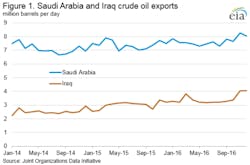US crude oil production increases following higher drilling activity
In November 2016, U.S. crude oil production saw its first consecutive monthly increase since April 2015, based on the latest U.S. Energy Information Administration (EIA) Short-Term Energy Outlook report. Fourth-quarter declines in production in some regions of the country were offset by increased drilling activity in the Permian in Texas and New Mexico, as well as the start of several new projects in the Federal Offshore Gulf of Mexico.
Liquefied natural gas exports expected to drive growth in US natural gas trade
The EIA’s recently released Annual Energy Outlook 2017 (AEO2017) projects the U.S. to become a net exporter of natural gas on an average annual basis. Declining pipeline imports, growing pipeline exports, and increasing exports of liquefied natural gas (LNG) are driving the transition to net exporter. The U.S. is also projected to become a net exporter of total energy in the 2020s primarily due to increasing natural gas imports, according to most AEO2017 cases.
Drilling Productivity Report forecasts production rise
For the first time since March 2015, more than five of the seven shale regions have seen month-to-month increases in natural gas gross withdrawals. As a result, the EIA in its most recent Drilling Productivity Report (DPR) is projecting increases in six of the seven most prolific shale regions in the lower 48 states from February to March. See full report here.
Graphic courtesy of the EIA
US crude oil imports from Saudi Arabia & Iraq increased
Record crude oil exports from Iraq and near-record exports from Saudi Arabia were achieved in November 2016 due to high production and seasonably low internal demand, according to the Joint Organization Data Initiative (JODI). That same month also saw price spreads in the market that supported high levels of U.S. crude imports from the two countries. But, market developments and agreement among certain Organization of the Petroleum Exporting Countries (OPEC) to reduce production suggests the growth will begin to decline. View the full report here.
China’s use of methanol in liquid fuels has grown rapidly since 2000
In an effort to better understand China’s consumption of methanol and its derivatives, the EIA commissioned a study by the Argus Media group, which found that the country’s use of methanol in liquid fuels has grown rapidly since 2000 and is estimated to have been more than 500,000 barrels per day (b/d) in 2016. The estimates developed in the study have now been incorporated into EIA’s historical data and forecasts of petroleum and other liquids consumption in China.
Tight oil expected to make up most of US oil production increase
U.S. tight oil production will increase to more than 6 million b/d in the coming decade, making up most of total U.S. oil production, the EIA projects in the AEO2017 Reference. After 2026, tight oil production is projected to remain mostly steady through 2040 as tight oil development moves into less productive areas and as well productivity decreases.
Graphic courtesy of the EIA
Projected electricity generation mix is sensitive to policies, natural gas prices
Expected cost of fuels and electricity-generating technology costs and their deployment has prompted the mix of fuels used to generate electricity in the U.S. to change. These factors, along with the policies affecting emissions from power generation, will determine the generation fuel mix in the years to come, according to the EIA’s AEO2017.
FERC enters no-quorum period
As of Feb. 3, only two of the three required commissioners on the Federal Energy Regulatory Commission (FERC) are needed to establish a quorum, according to the EIA.
Without a quorum, FERC’s hands are tied when it comes to issuing certifications of natural gas pipeline projects under its jurisdiction. FERC staff are still able to take limited action in key areas such as accepting and suspending rate and other filings; extending times for action on select matters; approving uncontested requests to waive tariff-related terms and conditions; and accepting uncontested settlements.




